
About UsThe Numismatic Bibliomania Society is a non-profit organization promoting numismatic literature. For more information please see our web site at coinbooks.org SubscriptionsThose wishing to become new E-Sylum subscribers (or wishing to Unsubscribe) can go to the following web page link MembershipThere is a membership application available on the web site Membership Application To join, print the application and return it with your check to the address printed on the application. Membership is only $15 to addresses in the U.S., $20 for First Class mail, and $25 elsewhere. For those without web access, write to: David M. Sundman, Treasurer AsylumFor Asylum mailing address changes and other membership questions, contact David at this email address: dsundman@LittletonCoin.com SubmissionsTo submit items for publication in The E-Sylum, just Reply to this message, or write to the Editor at this address: whomren@gmail.com
BUY THE BOOK BEFORE THE COIN |
- WAYNE'S WORDS: THE E-SYLUM AUGUST 25, 2013
- NBS EVENTS AT THE 2013 CHICAGO ANA
- NUMISMATIC LITERATURE AWARDS AT THE 2013 CHICAGO ANA
- NEW BOOK: CIVIL WAR STAMP ENVELOPES
- NEW BOOK: MEDIEVAL EUROPEAN COINAGE 6: THE IBERIAN PENINSULA
- NEW BOOK: HISTORY OF OTTOMAN COINS, VOLUME 7
- NEW BOOK: MILK TOKENS OF SWITZERLAND
- REPRODUCTIONS OF THE WATKINS BROADSIDE OFFERED
- BOOK REVIEW: ANATOMY OF AN INGOT
- CATALOG REVIEW: MISSOURI CABINET OF U.S. HALF CENTS
- BIBLIOPHILE BLINDED BY BLAZING NEWMAN COINS
- DEMONETIZING OLD CURRENCY
- NOTES FROM E-SYLUM READERS: AUGUST 25, 2013
- ERIC SCHENA'S NUMISMATIC DIARY: AUGUST 25, 2013
- HOW TO PACK BOOKS
- LOVE YOUR NUMISMATIC LIBRARIAN, 2013
- ENGRAVER GILROY ROBERTS AND THE FRANKLIN MINT
- WHY PUT A SILVER PLUG IN A SILVER COIN?
- THE 1952 BRITISH WEST AFRICA SIX PENCE
- MORE ON THE FIRST NATIONAL OYSTER BANK NOTES
- L. G. KAUFMAN'S BANKNOTE SIGNATURE
- OCTOBER 2013 KÜNKER AUCTION SALES REVIEW
- MONEY & MEDALS AUGUST 2013 ISSUE PUBLISHED
- TURKISH MUSEUM EXHIBITS ANCIENT COINS
- THE NUMISMATICS MUSEUM OF UDUPI, INDIA
- NUMISMATIC VOCABULARY WORDS: CRORE AND LAKH
- MORE ON 3D PRINTING AND NUMISMATICS
- CACHE OF DECADES-OLD UNTOUCHED CLASSIC AUTOS TO BE SOLD
- ON MADE-UP MEDICAL TERMS AND LIMERICKS
- FEATURED WEB PAGE: COLLECTING PAPAL COINAGE
Click here to access the complete archive
To comment or submit articles, reply to whomren@gmail.com
WAYNE'S WORDS: THE E-SYLUM AUGUST 25, 2013

New subscribers this week include Frank Pugliese, courtesy of John Mutch, Michael A. Merrill of Towson, MD, courtesy of Dave Schenkman, and Carl Lester. Welcome aboard! We have 1,669 email subscribers, plus 243 followers on Facebook.
Many thanks to Bill Eckberg and other readers who wrote to congratulate me on the E-Sylum's awards from the Numismatic Literary Guild. It was an honor and a pleasant surprise.
This week we open with reports from last week's American Numismatic Association convention, four new numismatic books, an offering of the Watkins broadside repros, and my review of Anatomy of an Ingot, the new book by Paul Franklin.
Other topics include Eric Newman's correspondence files, how to pack books for shipping, engraver Gilroy Roberts, the latest Money & Medals issue, printing silver and gold in 3D, and numismatic exhibits in Turkey and India.
To learn more about the Karl Goetz dies, Civil War Stamp Envelopes, milk tokens of Switzerland, Agoston Haraszthy, the Leamington Spa medal and the Crookshanks Barbershop token, read on. Have a great week, everyone!
Wayne Homren
Editor, The E-Sylum
NBS EVENTS AT THE 2013 CHICAGO ANA
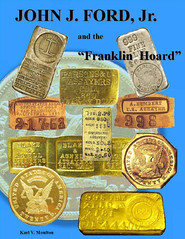 NBS Symposium Summary: Karl Moulton and the "Franklin Hoard."
NBS Symposium Summary: Karl Moulton and the "Franklin Hoard."
On Thursday, August 15, 2013, the Numismatic Bibliomania Society Symposium welcomed guest speaker Karl Moulton, who spoke about his new book, John J. Ford, Jr. and the “Franklin Hoard.” There was a good crowd of 30-40 audience members and Moulton spoke for about 30 minutes followed by 30 minutes of questions and further discussion.
Moulton’s book generated some buzz in the numismatic community when it was released this summer because of the focus of the subject matter, which has been of interest to many over the past few decades (not to mention the book's hefty 8 pound weight!). The book presents a good deal of documentation relating to the conflict between John J. Ford and Eric P. Newman surrounding the Franklin Hoard.
As Moulton repeatedly stressed during his presentation, this was not his story, but John J. Ford, Jr.’s and he was simply bringing all of the documentation together. In doing so, he tried to remain objective and did not attempt to authenticate or condemn any of the pieces, only to demonstrate the facts.
Moulton discussed his own interest in the Hoard started back in 1967, after John J. Ford, Jr. wrote a lengthy document in an attempt to authenticate the 1853 USAOG proof $20 gold coins. One of these coins had been the focus of a Professional Numismatics Guild arbitration hearing the previous year, which questioned the genuineness of those particular pieces. The resulting conflict ignited an interest in Moulton to fully explore the controversy and bring together the facts.
As a final point, there was an audience question that mentioned the 1999 ANA Chicago "Great Debate", which was recorded in VHS tapes, and I was surprised to learn that the only copies of this seem to be those in the ANS Library.
I will have more on Moulton’s presentation, the discussion of the controversy, and the audience reaction in my full article in the next issue of The Asylum!
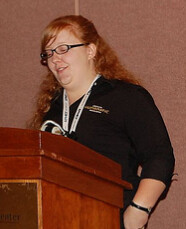
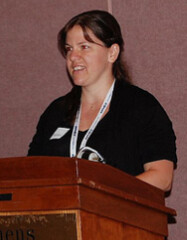
ANA Library Manager Kendra Johnson, ANS Librarian Elizabeth Hahn
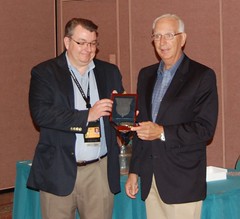 Here's Dan Hamelberg receiving the 2013 George Frederick Kolbe Award for Lifetime Achievement in Numismatic Literature from Marc Ricard.
Here's Dan Hamelberg receiving the 2013 George Frederick Kolbe Award for Lifetime Achievement in Numismatic Literature from Marc Ricard.
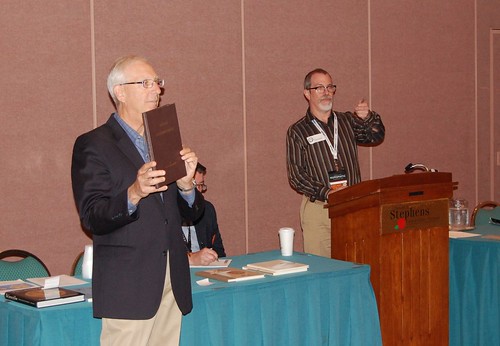
Charity auction run by Dan Hamelberg and Dan Freidus
NUMISMATIC LITERATURE AWARDS AT THE 2013 CHICAGO ANA
The American Numismatic Association presented 53 competitive exhibit awards at the 2013 World's Fair of Money in Rosemont, Ill. Winners were announced at the exhibit awards presentation and reception Aug 16 and at the awards banquet that evening.
Thirty-eight exhibitors of all ages and experience levels, showing 49 exhibits, competed in this year's program. There were also two non-competitive exhibitors showing two additional exhibits.
Lawrence Sekulich received the Howland Wood Memorial Award for Best-in-Show for his exhibit, "Hwenne Gold Was Smite in Coign."
Class 17: Numismatic Literature, Aaron Feldman Memorial. Printed and manuscript (published or unpublished) literature dealing with any numismatic subject.
First place: Jerry Fochtman, for "Dr. Daniel W. Valentine: Profile of a Numismatic Pioneer."
Second place: Mark Wieclaw, for "Roman Coins and Their Values: The Evolution of the Most Used Reference on Ancient Roman Coins."
Third place: no exhibit
The ANA's 2013 literary awards -- recognizing articles published in the 2012 volume of the ANA's official magazine, The Numismatist -- were presented on Aug. 15 at the ANA World's Fair of Money in Rosemont, Ill. The Numismatist was first published by ANA founder and inaugural editor Dr. George F. Heath in 1888 and this year celebrates its 125th anniversary.
The Heath Literary Award, introduced in 1949, acknowledges outstanding articles published in the preceding year. First place went to Q. David Bowers for his March 2012 article, "Era of Secrecy," which focused on the U.S. Mint’s practice of striking special coins for collectors in the late 1800s. Bowers received $250, a silver medal and a certificate. Bowers generously donated his $250 prize money to the ANA’s Dwight N. Manley Numismatic Library.
Nancy Oliver and Richard Kelly, co-authors of the magazine’s monthly “Numismatic Chronicles” column, took second place ($100, a bronze medal, and a certificate) for their article "On the Wrong Track” (September 2012), describing a daring 1877 train robbery in which the perpetrators got away with thousands of double eagles. Bibliophile David F. Fanning received third place (a bronze medal and a certificate) for "Top 10 American Numismatic Books of the 19th Century" (February 2012), which exemplified how classic references continue to inform today’s collectors.
The Wayte and Olga Raymond ¬Memorial Literary Award, endowed by the late John J. Ford Jr., is presented for articles in The Numismatist that display original and comprehensive research in U.S. numismatics. Mark Fox for "In Search of Machin’s Mill’s" (December 2012) received first-place honors ($400 and a certificate), and David E. Schenkman was awarded second place ($200 and a certificate) for "The Numismatic Legacy of S.D. Childs" (October 2012).
Funded by an anonymous donor, the Catherine Sheehan Literary Award for U.S. Paper Money Studies was presented to two authors. First place ($50 and a certificate) went to P. Scott Rubin for "New Jersey Currency of 1776" (July 2012), which considered Revolution-era notes and a historic hoard. Gerome Walton received second-place honors (certificate) for "Nebraska’s Smallest National Bank Town" (August 2012), in which he explained how surviving $10 and $20 notes tell the story of tiny St. James, Nebraska.
Additional coverage of awards can be found in the September issue of The Numismatist --page 74.
Bradley S. Karoleff is the 2013 recipient of the American Numismatic Association Harry J. Forman Dealer of the Year Award, an award that was presented Aug. 13 at the World's Fair of Money Kick-Off event.
The award is presented annually to an ANA-member dealer who shows uncommon dedication to strengthening the hobby and the Association. The award is named in honor of the late Harry J. Forman, a Philadelphia coin dealer, author and ANA life member.
A prolific writer, Karoleff is a contributor to several publications, including: “A Guide Book of United States Coins” and “Handbook of United States Coins,” commonly known as the Red Book and Blue Book; Coin World; The Numismatist; he was co-author of the John Reich Collectors Society book: “Early Quarter Dollars of the United States Mint 1796-1838”; and he is the longtime editor of the John Reich Journal, which is the official publication of the John Reich Collectors Society.
Thank you, Wendell! This award comes on my fiftieth anniversary of joining ANA (# 44246, Don Scherer) and just before my 40th anniversary as Life Member #1973. ANA membership is a delightful contrast with an English organization I joined in 1967 which defined Life Membership as “seven years or DEATH, whichever comes first !!!” I got to know ANA in the early 1950s, reading The Numismatist in the Reference Room in the new Miami Public Library, which also had shelves of CIRCULATING coin books, a rare situation for the time.
I think it is great that the firm with which I am associated, HARLAN J. BERK LTD. of Chicago, has already had two Numismatists of the Year: founder Harlan J. Berk and my good friend and recent NEWLYWED Tom DeLorey!!! We are the only numismatic firm that can claim this achievement!
Discussing this award with my colleague Barbara Gregory, I said that to me, numismatics is a very human thing! Money and value are certainly involved, and the collector has yet to be born who doesn’t gloat, if only in secret, over the growing value of his or her collection! Certified grading and “Slabbing” have reduced Numismatics for some of us to “two letters and two numbers on two pieces of plastic,” but it is vastly MORE!! Numismatics is as wide as the world, and NUMISMATIST should be a title of honor!
Going beyond the value, history and lore of coins is the reward of personal interaction with a cavalcade of friends and mentors past and present. Coming immediately to mind is my wonderful wife of 36 years, Pat. Dealers and co-workers, I was privileged to know were Abe Kosoff, William Fox Steinberg, Paul Kagin, Harvey and Larry Stack, John J. Ford Jr., Carl Carlson, Bob Archer; writers and publishers, Dr. John S. Davenport, COIN WORLD’S Margo Russell, Jay Guren, Russ Rulau, Beth Deisher, COINage Jim Miller, Lee Martin, Ed Reiter. ANA: Virginia Culver, Col. Grover C. Criswell, Virgil Hancock; ANS, Ute Wartenberg-Kagan; many friends in NLG, MCA, SIN, the New York Numismatic Club. My thanks go to all and hundreds more that I wish time would permit me to mention by Name!
THE BOOK BAZARRE
NEW BOOK: CIVIL WAR STAMP ENVELOPES
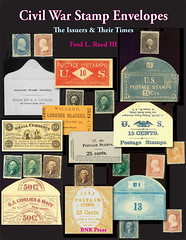 BNR Press announces the mid-October release of Fred Reed’s latest book, Civil War Stamp Envelopes, the Issuers and Their Times, 672 pages, 8.5 x 11inches, approx. 1,500 illustrations, $59.95 softcover or $79.95 hardcover (not Smyth-sewn), postage, handling and insurance per book $10.
BNR Press announces the mid-October release of Fred Reed’s latest book, Civil War Stamp Envelopes, the Issuers and Their Times, 672 pages, 8.5 x 11inches, approx. 1,500 illustrations, $59.95 softcover or $79.95 hardcover (not Smyth-sewn), postage, handling and insurance per book $10.
Noted Civil War student and author Fred Reed’s latest opus on the turbulent monetary period of the U.S. Civil War era, Civil War Stamp Envelopes, the Issuers and Their Times, is available for purchase right now, according to a spokesman for the publisher, BNR Press, Portage, Ohio.
Mr. Reed is well known in the hobby for his intensive research and writings and the new book is his second in a projected seven volume look at mid-19th century money in a series that began 19 years ago with the similarly titled companion volume, Civil War Encased Stamps, the Issuers and Their Times. That book, also published by BNR Press, earned several major hobby and publishing awards, and finished high on the Numismatic Bibliomania Society’s survey of the “most important” numismatic books of all time.
Reed calls the new book Part III of his “A Numismatist’s Perspective of the Civil War” series. His encased stamp book was published as Part II. Part I will look at the federal and private Postage Currency. Part IV looks at Civil War era counterfeiting. These last two subjects have been special interests of the author for many years, and have been addressed repeatedly by Reed in the various numismatic periodicals.
“Readers familiar with the earlier book will feel at home this time around too,” Reed notes. “My book covers the same fertile ground, the Civil War small change shortage of 1862-1863 that gave rise to the encased stamps that I wrote about years ago, the Postage Currency that I have addressed repeatedly in my Bank Note Reporter columns, and now these Civil War postage stamp envelopes that I catalog, illustrate and provide history, rarity, and prices for in the new book,” he added.
The book is subtitled “A History, Merchant Chronicle, Catalog, [and] Auction Summary, of the Postage Stamp Envelope Emergency Money of 1862.” The author provides amply-illustrated chapters, essays that he labels “merchant chronicles,” on each of the 128 known issuers of this emergency scrip. The catalog numbers employed in the new book are the same ones collectors have already become familiar with in the last two editions of the Friedberg’s Paper Money of the United States for which author Reed provided a catalog extract from the present work that was published in the 19th and 20th editions of PMUS.
Reed’s new opus catalogs 514 different varieties of the small envelopes that were printed to contain and preserve U.S. postage stamps in circulation as small change in summer and fall 1862. Almost all varieties are illustrated, and extensive census and provenance data given, along with auction prices realized for these scarce monetary instruments over the last century of their active collecting.
“Collectors and dealers too will finally know which of these pieces are actually the rarest and potentially the most valuable instead of guessing or having to rely on the uninformed opinions of others,” Reed jested. “For the last 40 years this marketplace has been a crap shoot, a roller coaster ride up to and over the five-figure price level with no seatbelts. My book will level the playing field among those who have access to its wealth of information. Then dealers and collectors alike can make informed, intelligent purchase and sales decisions,” he said.
The author credits more than 200 individuals and institutions for their assistance, and several of the prominent auction companies in this field that have unselfishly provided him illustrations and information. He also thanks Central States Numismatic Society and the Society of Paper Money Collectors who provided funding for his research over the past six years. A journalist for more than 40 years, Reed also develops the narrative history of the collecting and cataloging of this series that spans numismatics, philately, and paper money collecting.
Reed has also had unprecedented access to all the great collections of the last two generations, and learned a great deal of “inside scoop” that is faithfully reported here for the first time ever. “I’m proud to say that the ‘fore-matter’ of the book includes essays by Chet Krause and Art Paradis, the two individuals who have formed the largest known collections of this series ever put together.”
“Postage and Fractional currency collectors especially should be interested in this forerunner stamp money,” author Reed suggests. Knowing why, how and when these emergency instruments were used in the marketplace can bring the fractional note collectors additional insights and pleasure with their own collections whether or not they choose to embark on this until now poorly delimited and quantified series,” he added.
Books are expected to ship in mid-October. Orders may be sent to the author Fred Reed at Department E, PO Box 118162, Carrollton, TX 75011-8162. Please include correct postage ($10/book including insurance), Reed noted, and whether you want the volume(s) autographed. Information on bulk orders and pre-publication discounts may be obtained from the author at fred@spmc.org or through his website www.fredwritesright.com and mention you heard about the book in The E-Sylum.
Kudos are also due the Central States Numismatic Society and the Society of Paper Money Collectors for providing funding for Fred's research. Great books don't happen by accident - lots of time, effort, and money are required to make them a reality. Buyers are getting a bargain. -Editor
NEW BOOK: MEDIEVAL EUROPEAN COINAGE 6: THE IBERIAN PENINSULA
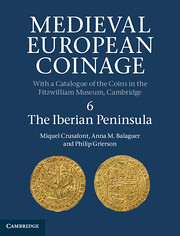 Medieval European Coinage
Medieval European Coinage
Volume 6. The Iberian Peninsula
Part of Medieval European Coinage
AUTHORS: Miquel Crusafont, Societat Catalana d'Estudis Numismatics BarcelonaAnna M. BalaguerPhilip Grierson, University of Cambridge
This volume of Medieval European Coinage is the first English-language survey to bring the latest research on the coinage of Spain and Portugal c.1000-1500 to an international audience. A major work of reference by leading numismatic experts, the volume provides an authoritative and up-to-date account of the coinages of Aragon, Catalonia, Castile, Leon, Navarre and Portugal, which have rarely been studied together. It considers how money circulated throughout the peninsula, offering new syntheses of the monetary history of the individual kingdoms, and includes an extensive catalogue of the Aragonese, Castilian, Catalan, Leonese, Navarrese and Portuguese coins in the collection of the Fitzwilliam Museum. This major contribution to the field will be a valuable point of reference for the study of medieval history, numismatics, and archaeology.
Product details
PUBLISHED: July 2013
FORMAT: HardbackISBN: 9780521260145
LENGTH: 929 pages
DIMENSIONS: 252 x 199 x 57 mm
WEIGHT: 2.19kgCONTAINS: 136 b/w illus. 7 maps 41 tables
AVAILABILITY: In stock
For more information, or to order, see: Medieval European Coinage Volume 6. The Iberian Peninsula (www.cambridge.org/us/academic/subjects/history/european-history-1000-1450/medieval-european-coinage-volume-6)
NEW BOOK: HISTORY OF OTTOMAN COINS, VOLUME 7
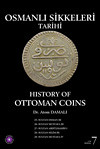 History of Ottoman Coins Vol. 7 / Osmanli Sikkeleri Tarihi - Cilt 7
History of Ottoman Coins Vol. 7 / Osmanli Sikkeleri Tarihi - Cilt 7
Author: Damali, Atom
Publisher: Nilufer Damali Egitim, Kultur ve Cevre Vakfi
ISBN: 9786058592605
Publication Date & Place: 2013, Ýstanbul
Dimensions: 215x305mm, 2500 gr.
Price: 110,00 € (Direct Delivery)
Book details
420 pp, color figures, hb, in Turkish-English bilingual.
OTTOMAN SULTANS - Osman III - Mustafa III - Abdülhamid I - Selim III - Mustafa IV
The Ottoman Empire was endowed with the power of creating one of the most extensive numismatic histories of the world by having coins minted at more than 130 mints as of the 14th century. However, the fact that the Ottoman coins had presence in very few mints whose collective number did not exceed the number of fingers in one hand as of the mid-18th century is the most obvious indicator of the crucial changes in the Ottoman history and economy.
These developments which greatly affected coin minting can be summarised briefly as follows:
The provinces, where gold or silver coins were minted in addition to Istanbul, were limited with Baghdad, Algeria, Egypt, Tripoli and Tunisia from the enthronement of Sultan Osman III, the 25th Ottoman sultan, to the end of the Empire. Two common features catch the eye when we analyze the history of these provinces that were very critical for the Ottoman Empire...
The present volume of this work, which is expected to be completed in nine volumes, covers the reigns of sultans Osman III, Mustafa III, Abdulhamid I, Selim III and Mustafa IV, and contains:
- Year-by-year chronological information regarding the 54 years of these sultanates;
- The most significant historical developments of this period;
- Detailed information on coins.
This volume includes the details of 71 coins of Sultan Osman III, 460 coins of Sultan Mustafa III, 401 coins of Sultan Abdulhamid I, 409 coins of Sultan Selim III and 56 coins of Sultan Mustafa IV; i.e. 1478 gold and silver coins. Additionally, the book provides the local history of all provinces which issued coins during these reigns and examines the characteristics of the coins minted in these provinces.
An inventory of the coins belonging to the sultans is provided at the end of the book.
For more information, or to order, see: History of Ottoman Coins Vol. 7 / Osmanli Sikkeleri Tarihi - Cilt 7 (www.zerobooksonline.com/eng/product_details.asp?cat=&subcat=&product=8183)
NEW BOOK: MILK TOKENS OF SWITZERLAND
 Adrián González-Salinas writes:
Adrián González-Salinas writes:
I was looking for "glas bier tokens" in Amazon and I found the following Swiss book: "Milchmarken der Schweiz"
Jetons Marken Molkerein - Geschichte Numismatischer Katalog mit Bewertungen / Milk Jetons - Token in Switzerland Chips Brands Dairies - History Numismatic Catalog (Fully in colour - komplett in Farbe)
Hardcover – January 1, 2013
Hardcover: 600 pages
Publisher: Gietl & Battenberg Verlag Publisher , Germany; 1th 1. edition (2013)
ASIN: B00DRH0UX0
To order, see: Milchmarken der Schweiz Jetons Marken Molkerein (www.amazon.com/Milchmarken-Schweiz-Jetons-Marken-Molkerein/dp/B00DRH0UX0)
I found another listing on the publisher's site, which lists the publication date as "2013/2014": Milchmarken der Schweiz (www.gietl-verlag.de/milchmarken-der-schweiz/buchdetail/307/1/themen/neuerscheinung.html)
I contacted CoinsWeekly editor Ursula Kampmann, who writes:
I contacted the editor and the book has not been published yet. It will be on the market in November 2013. I have asked for a review copy. When I get it, I will write a short review of the book.
The Gietl Verlag which has edited the book is the most important numismatic editor in Germany. And Ruedi Kunzmann has already published a catalogue of the beer tokens of Switzerland. He is also co-editor of the most important catalogue of Swiss money from ancient to modern times.
REPRODUCTIONS OF THE WATKINS BROADSIDE OFFERED
Dan Hamelberg writes:
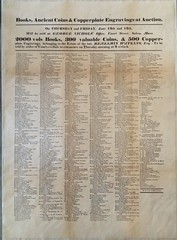 Regarding the Attinelli Watkins reproductions, as Joel pointed out in his article, there is one copy in the library of the American Numismatic Society. With Frank Campbell's help, I discovered the Attinelli Watkins reproduction when he was ANS librarian. The ANS also has the only known original of the Watkins broadside.
Regarding the Attinelli Watkins reproductions, as Joel pointed out in his article, there is one copy in the library of the American Numismatic Society. With Frank Campbell's help, I discovered the Attinelli Watkins reproduction when he was ANS librarian. The ANS also has the only known original of the Watkins broadside.
I managed to find a source for high quality facsimiles a few years ago, and commissioned the production of a number of new facsimiles from the original Watkins broadside. I donated them to the ANS, and so the ANS now has a number of Watkins broadside facsimile's of the Original broadside for sale. All proceeds go to help with ANS library conservation projects. For availability and pricing, contact ANS Librarian Elizabeth Hahn at hahn@numismatics.org .

To read the earlier E-Sylum article, see: THE UNSOLVED MYSTERIES OF NUMISGRAPHICS (www.coinbooks.org/esylum_v16n34a17.html)
BOOK REVIEW: ANATOMY OF AN INGOT
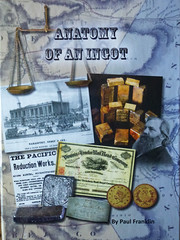 Anatomy of an Ingot by Paul Franklin
addresses the history of one particular silver ingot from the John J. Ford collection.
As I'd hoped, this is another of the "single coin books" that I enjoy for their focused, in-depth numismatic research.
It passes my "back of the book" test with flying colors for its inclusion of a thirteen-page Index, twelve-page Bibliography and a four-page Glossary of Terms.
Anatomy of an Ingot by Paul Franklin
addresses the history of one particular silver ingot from the John J. Ford collection.
As I'd hoped, this is another of the "single coin books" that I enjoy for their focused, in-depth numismatic research.
It passes my "back of the book" test with flying colors for its inclusion of a thirteen-page Index, twelve-page Bibliography and a four-page Glossary of Terms.
The author has clearly done a tremendous amount of research in the obscure but fascinating field of precious metals assaying in the early mining days of the American West. Focusing on three assayers associated with the ingot (Mathey, Kustel and Riotte), the book spans the second half of the 19th century and covers much of the early mining history in California and the territories of Arizona and Nevada.
The ingot was lot #3524 in the October 16, 2007 Stack's Ford Sale Part XXI. Its earlier provenance includes the Waldo Newcomer collection, B. Max Mehl and Art Kagin.
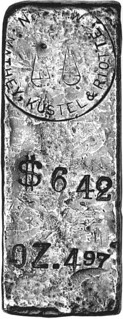 From the book's press release:
From the book's press release:
The most significant of the three assayers was Guido Kustel, who worked in the early San Francisco assay business with well-known names such as Wass, Molitor and Harazsthy. A German trained Mining Engineer and Metallurgist, Kustel ventured off to the Apache infested mountains of Southern Arizona to build the first assay and refining facilities at the famous Heintzelman Mine. He returned to California just in time to become one of the principal players in the early Comstock mining boom in Nevada. Although not a household name today, Kustel was one of the most famous mining engineers and assayers of his day, publishing three books that became ‘must haves’ for every mining engineer. He returned to San Francisco where he set up a number of assay offices and refineries.
The second player was Eugene N. Riotte, also trained in Germany, who travelled to Nevada just in time to participate in the newly discovered Reese River silver mines around Austin. He was later involved with a number of other assayers and mining engineers in solving the problems in refining the complex silver ores of Nevada.
The third member, Henry Mathey, emigrated from the gold mines of South America to the early mines of Darwin near Death Valley. Joining Kustel and Riotte in 1880 they set the stage for the origin of the silver ingot in question, but not in a way that one might have guessed. Mathey would go onto other achievements including developing the first tin mine in the United States.
While numismatists interested in these rare early ingots would certainly enjoy the book, there are tidbits throughout that can enlighten those interested in pioneer gold coinages and the early history of the San Francisco Mint.
The list of characters appearing in the book is a long one. I was pleased to see discussions of Agoston Haraszthy, the San Francisco Mint Assayer who was accused of stealing gold but was exonerated in the end when it was discovered that the unaccounted-for gold had gone up the chimney and been deposited on the roofs of nearby buildings. Naturally, this discovery led to improvements in the gold processing process.
Haraszthy later founded a pioneering winery that still exists today in the wine country north of the city. Franklin's book alerted me to the existence of a biography: "McGinty, Brian, Strong Wine, The Life and Legend of Agoston Haraszthy, 1998, McGinty does a fine job researching and detailing the life of Agoston Haraszthy, one of America's most fascinating men."
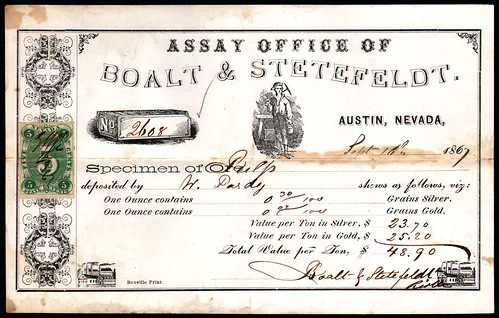
Figure 89, Page 137
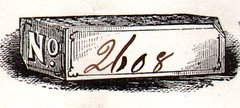 The book is very well illustrated in both black and while and color, with images on nearly every page. Above is an 1867 assay office receipt of Boalt & Stetefeldt of Austin, NV. These receipts are interesting collectibles in themselves as well as valuable records of bullion transactions. "Note the certificate number, No. 2608 is located within an image of an ingot with assay chips cut off opposing corners."
The book is very well illustrated in both black and while and color, with images on nearly every page. Above is an 1867 assay office receipt of Boalt & Stetefeldt of Austin, NV. These receipts are interesting collectibles in themselves as well as valuable records of bullion transactions. "Note the certificate number, No. 2608 is located within an image of an ingot with assay chips cut off opposing corners."
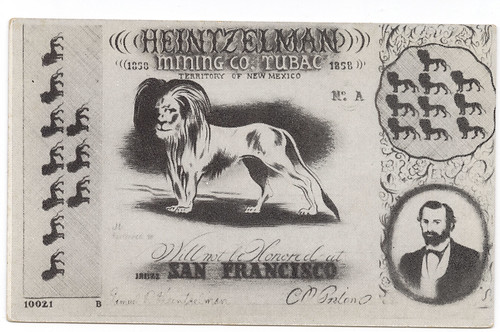
Figure 24, Page 43
In addition to the great back-of-the-book research documentation, there are detailed footnotes on every page. Note #97 describes the source of the above sample of the scrip notes used at the Heintzelman Mining Co. of Tubac, Arizona Territory. The lion denotes the $10 denomination (and ten lions are depicted at the left and right sides of the note).
This is an unusual style of scrip, and I'd never seen a note by this issuer before. The footnote is particularly tantalizing because the source is unpublished. Kudos to author Franklin for uncovering this gem (and so many others). Here's the text of the note:
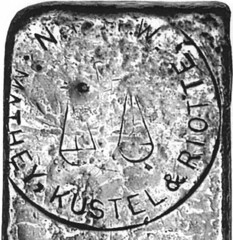
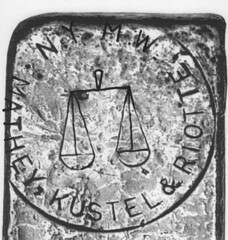
Figures 129 and 130 , Page 193
Chapter 16 is titled "Re-Examination of the Ingot". It's a short chapter. The book never questions the authenticity of the ingot, but with a provenance back to the Newcomer collection it hasn't been entangled in the Ford controversies. Rather, this chapter is about using the knowledge gained in the book's research to fill in the gaps in the ingot's weakly-struck lettering.
The letters N, Y, M, W would represent New York Metallurgical Works, a probable sequence of letters that partially appears on the subject ingot's logo stamp. Now the design of the complete logo stamp used, along with the center image of assayer's scales is easily reconstructed (Compare figures 129 nd 130).
It now becomes somewhat easier to date the subject ingot: it was most probably made in the second half of 1880 just after the founding of the New York Branch given its low serial number and the stamp containing all three names, Mathey, Kustel and Riotte.
Author Franklin adds:
Figure 130 was a copy of figure 129 on which I edited some changes extrapolated from my research towards representing how the original logo punch might have appeared.
As a numismatic bibliophile I'm clearly thrilled with the book. With its narrow focus on assaying and mining though, it won't be every numismatist's cup of tea. But anyone with an interest in this fascinating era of history should enjoy reading it, and it will be a fine companion to titles such as Dan Owens, California Coiners and Assayers, Q. David Bowers, A California Gold Rush History, Donald Kagin, Private Gold Coins and Patterns of the United States (upcoming 2nd edition), and one of my favorite obscure numismatic-related books, Brian McGinty, Haraszthy at the Mint.
To read the earlier E-Sylum article, see: NEW BOOK: ANATOMY OF AN INGOT (www.coinbooks.org/esylum_v16n33a04.html)
CATALOG REVIEW: MISSOURI CABINET OF U.S. HALF CENTS
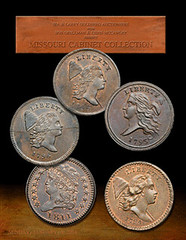 On Friday I got my hardcover copy of the Missouri Cabinet catalogue. This is the Goldberg's sale of the finest collection of U. S. half cents ever offered at auction. Only 100 hardcovers were produced. The regular catalogue was available at the recent ANA convention. The sale is next January 26th in Los Angeles.
On Friday I got my hardcover copy of the Missouri Cabinet catalogue. This is the Goldberg's sale of the finest collection of U. S. half cents ever offered at auction. Only 100 hardcovers were produced. The regular catalogue was available at the recent ANA convention. The sale is next January 26th in Los Angeles.
I have been collecting coin catalogues, going back to the 19th century, for almost 30 years . This is the best copper catalogue I have ever seen. There are only 230 lots, but each lot has its own page. For the great half cents there are 3 pages (full page color photos of obverse and reverse and the 3rd page has the description) devoted to the one lot, while the near great coins get 2 pages (obverse and reverse photos on same page).
The color photography is great as are the descriptions by Bob Grellman. For each coin he gives the PCGS slab and EAC grade, as well as the Manley die state. This catalogue matches the coins in the sale. For those who missed out on the hardcovers - the last two lots in the sale are Super-deluxe editions in full Moroccan leather that includes a special plate section. Only nine of these have been produced. Good luck.
For more information, see: www.goldbergcoins.com
THE BOOK BAZARRE
BIBLIOPHILE BLINDED BY BLAZING NEWMAN COINS
I had the opportunity to spend a few days with Eric at his home in St. Louis. The first day we visited the bank where Eric kept his coins and some rare books. He told me that he had an extremely rare book that he wanted to show me.
As we entered the vault, he pulled out one key from his pocket. It unlocked a small sized box. That box in turn contained all the rest of the keys for his various sized boxes in the vault. He opened up a large box and started looking for the book.
As he rooted through the box, he handed me a few old Raymond coin book albums to hold on to as he searched. The first album contained early bust quarters. The 1796 was a high grade unc. The others were also uncirculated as well. As I moved the album back and forth to see the luster, I started to get numb.
Then he handed me the Bust Half Dollar album. The 1794 and the 96' - 97's appeared unc. Again I moved the albums back and forth to see the luster and now I was totally entranced.
Eric finally found the book he wanted to show me. I can recall that he handed me the book, but to this day, I cannot remember what it was. I was still dazed by the coins I was holding at the time. I am sure it was a really rare book, but the coins knocked me out to where I was not fully aware of much else.
I remember a bank official coming into the vault and telling Eric that the bank was closing and we had to leave. As I left the vault, I started to come out of my trance and back to reality. I remember the coins. I do not remember the book.
I visited Heritage's table at the recent ANA show and viewed some of the coins consigned for the upcoming Eric Newman sale. I saw a few of my old friends from the vault. The book remains a mystery.
I shared this story with Maureen and Stuart Levine, who write:
We can certainly attest to the "wow factor" of seeing Eric's collection in the vault. Time flies by and it's suddenly closing time at the bank. Many of those who examined the EPNNES coins at the Chicago ANA expressed a feeling of amazement similar to Dan's. And, as noted in Coin World, there really is something for everyone in the upcoming sale.
After dinner, we went back to Eric's house. We stayed up past mid-night talking and viewing some of the numismatic ephemera he kept at home. Old fixed price lists, dealer flyers, bank note reporters, pamphlets and brochures galore! I stayed in the quest room which was quite large and comfortable.
The next morning, Eric came in the room while I was finishing packing and putting the room back in order. He sat himself down on a chair, and started telling me some of his early experiences. My favorite story was about his honeymoon in South America. I don't remember the town, but he and his new wife were staying in a coastal town with a large harbor to the Atlantic Ocean. The word came that a German ship was going to enter the harbor soon, and the town's people were not pleased. The time was just prior to U.S. involvement in WWII, and there was a large anti-German feeling in the town. Eric joined a number of locals and floated an old barge out to the harbor entrance and sank it so the German ship could not enter. What a great honeymoon adventure!
After the stories, Eric and I went downstairs for breakfast. Eric's wife is a great hostess and very attentive to him. She told me that Eric had not stayed up so late in many years. After breakfast, we went down to the basement where he kept his collection of counterfeit coin detectors. As we walked thru the basement rooms, I saw a number of large bank style coin counters and wondered how Eric was able to get them into the basement.
When we got to the room where the detectors were kept, we sat down at a large table that was surrounded by four-drawer vertical file cabinets. The file cabinets acted like walls around the large table where the detectors were kept. I asked Eric what was in the file cabinets, and he replied that they contained all the correspondence he had with dealers and collectors for all the years of his numismatic career. What a treasure trove of information!
We spent a few hours reviewing the counterfeit coin detectors, and I tried my best to acquire a few of his duplicates that I needed for my collection. Eric politely said he would rather keep them all at that time. We talked about many numismatic topics, and the time passed quickly. We went back upstairs, and before I left for home we had a light lunch.
Without question, my visit to Eric's home is one of the highlights of my numismatic experiences. I believe the phrase is "a gentleman and a scholar," and it most certainly applies to Eric. Eric Newman is a treasure to the numismatic community.
DEMONETIZING OLD CURRENCY
David Pickup writes:
With reference to your query about countries which do not demonetise their old currency there was a BBC story about Germany recently. Although the German Mark is not legal tender it still can be changed to euros.
 Germans are still holding on to billions of Deutschmarks, nearly eight years after the currency was phased out, Germany's central bank says.
The Bundesbank has given an overall figure of 13.6bn Deutschmarks - worth about 7bn euros (£6.3bn).
Germans are still holding on to billions of Deutschmarks, nearly eight years after the currency was phased out, Germany's central bank says.
The Bundesbank has given an overall figure of 13.6bn Deutschmarks - worth about 7bn euros (£6.3bn).
The Bundesbank has set no deadline for exchanging Deutschmarks for euros and no fee is levied when Germans do so. Nearly DM160m was exchanged for euros in 2009, said Bundesbank spokeswoman Adelheid Sailer-Schuster.
The Deutschmark ceased to be legal tender on 1 March 2002. But there were many complaints at the time that traders were using the switch from Deutschmarks to disguise price mark-ups.
To read the complete article, see: Germans hang on to billions of Deutschmarks (news.bbc.co.uk/2/hi/europe/8441503.stm)
David adds:
Another point that occurred to me is what amounts of coins are legal tender. In this country copper coins – one and two pence - are only legal tender up to twenty pence worth. So you could not pay a tax bill in pennies. I do not know if you have an equivalent law in the US
Joe Boling writes:
The Bank of England will still redeem any of their obsolete notes, even though they have lost their legal tender status in commerce. In practice, many London banks will also exchange obsolete BoE notes that can no longer be used in trade.
No one-yen note of the Bank of Japan has ever been demonetized. That is why one-yen notes illustrated in books have specimen markings imposed on them, no matter their age. Pre-1946 Bank of Japan notes are no longer exchangeable, and no specimen markings are needed on them when published.
Most writings on banknotes by bank tellers are numerals indicating the amount of money in the stack, when less than a full strap is involved (50 or 100 notes). They write the numbers on the watermark window, a convenient blank space that begs to be "scribbled" on.
To read the earlier E-Sylum article, see: QUERY: WHICH COUNTRIES HAVEN'T DEMONETIZED THEIR OLD MONEY? (www.coinbooks.org/esylum_v16n34a15.html)
NOTES FROM E-SYLUM READERS: AUGUST 25, 2013
On the E-Sylum 2013 NLG Awards
Eric Schena writes:
Congratulations on the E-Sylum's awards - they truly are well earned and deserved! I cannot imagine producing such a comprehensive and consistently amazing publication like that on a weekly basis. It's always a must-read for me every Sunday.
Fred Michaelson writes:
CONGRATULATIONS for having the brains, the knowledge, and the drive and motivation to run an award-winning and very unique operation!!
To read the earlier E-Sylum article, see: E-SYLUM WINS 2013 NLG AWARDS (www.coinbooks.org/esylum_v16n34a02.html)
Discounts on the New Jersey State Coppers Book
A reader asked about the availability of the pre-publication discount for the new book on New Jersey State Coppers. I checked with Joanne Isaac at the American Numismatic Society, who writes:
The member price of $165 is being offered to ANS and C-4 members - as the ANS and C-4 are co-publisher of New Jersey Coppers.
So while members of the Colonial Coin Collectors Club (C4) are eligible for the discount, other club members such as Early American Coppers (EAC) members are not (unless they are also members of ANS, C4, or both).
To read the earlier E-Sylum article, see: NEW BOOK: NEW JERSEY STATE COPPERS (www.coinbooks.org/esylum_v16n34a03.html)
A Note on the Goetz Dies
Regarding their recent sale of Goetz dies, Michael Peplinski of Heritage Auctions writes:
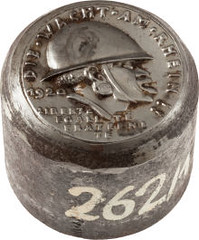 “I was recently contacted by Henry Goodman at KarlGoetz.com about a discrepancy in my note published in your newsletter a while back. I mentioned that the Goetz dies were purchased from the Goetz family recently, which was incorrect. Actually, the dies were purchased from the Goetz family many years ago, but were recently consigned to our sale by their owner. As a reminder to interested collectors, Part II of the Goetz Medal Die Archive consisting of 338 dies will be available for bidding in the Heritage September Long Beach Auction.”
“I was recently contacted by Henry Goodman at KarlGoetz.com about a discrepancy in my note published in your newsletter a while back. I mentioned that the Goetz dies were purchased from the Goetz family recently, which was incorrect. Actually, the dies were purchased from the Goetz family many years ago, but were recently consigned to our sale by their owner. As a reminder to interested collectors, Part II of the Goetz Medal Die Archive consisting of 338 dies will be available for bidding in the Heritage September Long Beach Auction.”
To read the earlier E-Sylum article, see: HERITAGE AUCTIONS ON THE KARL GOETZ DIE CONSIGNMENT (www.coinbooks.org/esylum_v16n16a09.html)
Attribution Sought for Crookshanks Barbershop Token
Lloyd Wagner writes:
I have a mystery barbershop(?) token. I cannot find any attribution for this piece, and thought your readers might recognize it. Thanks for any help.

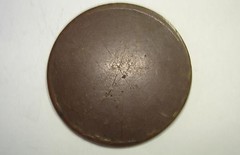
ERIC SCHENA'S NUMISMATIC DIARY: AUGUST 25, 2013
Tuesday was our monthly gathering of Nummis Nova, this time hosted by Julian Leidman. Unfortunately, our Fearless Leader (to borrow a phrase), Wayne Homren, was unavailable to join us. Eleven of us met at Jerry's Seafood in Lanham, MD. I sat at one end of the table with Gene Brandenburg, Dave Schenkman, Jon Radel, Joe Levine, Andy Singer, while Ron Abler, Steve Bishop, Michael Merrill, Lenny Goldberg, and Julian sat at the other.
Dave had invited long-time Baltimore coin dealer Michael Merrill to join us. He and Dave told great stories about their brushes with fame in the music world, including the time Johnny Cash came to Michael's shop, and the Rolling Stones bought a banjo from Dave.
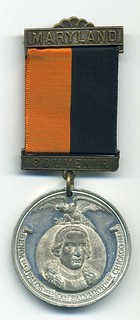
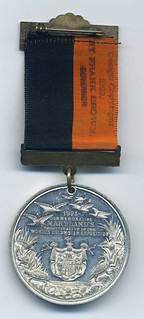
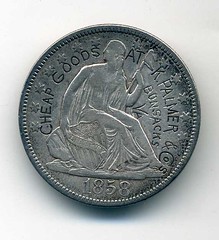 Since Dave was recently awarded the ANA's highest honor, the Farran Zerbe Award, the theme was to try to stump him, though many of us brought some recent acquisitions from the World's Fair of Money. For my part, I brought a couple of local Maryland medals in honor of our location, including a white metal souvenir medal commemorating Maryland's participation in the 1893 World's Columbian Exposition in Chicago, an 1854 quarter countermarked "Jordans Springs" from the Winchester, Virginia area, and a really neat 1858 half that was delicately engraved with "Cheap Goods at K. Palmer & Cos., Bonsacks, Va."
Since Dave was recently awarded the ANA's highest honor, the Farran Zerbe Award, the theme was to try to stump him, though many of us brought some recent acquisitions from the World's Fair of Money. For my part, I brought a couple of local Maryland medals in honor of our location, including a white metal souvenir medal commemorating Maryland's participation in the 1893 World's Columbian Exposition in Chicago, an 1854 quarter countermarked "Jordans Springs" from the Winchester, Virginia area, and a really neat 1858 half that was delicately engraved with "Cheap Goods at K. Palmer & Cos., Bonsacks, Va."
Andy Singer brought a beautiful silver grosso of Pope Sixtus IV, which bears the first realistic portrait of a pope. Lenny passed around a selection of interesting tokens from New Mexico and Jon brought a telephone token from Thailand that he thinks was used as a test piece. I am not sure anyone was able to stump Dave, though.
Much of what we discussed was centered around the ANA's World's Fair of Money in Rosemont and the Stacks Bowers auction - quite a few of the folks around the table made the trek there the previous week. Since a number of us exonumists were at my end of the table, we talked about how strong much of the Ford tokens realized.
The catalog will likely be an important reference, especially for his countermarked coins and I, for one, liked the spiral binding and full color printing of the catalogs, even if I was not able to add a single Ford piece into my collection. That said, for me, I enjoyed the show itself and I was able to add quite a number of items from the bourse floor to my Mid-Atlantic collection.
The BEP's section was astonishing- they brought some superb one of a kind items, including several large denomination uncut sheets - it's not every day you see an uncut sheet of $100,000 gold certificates. Seeing the Rittenhouse half disme, his appointment certificate, as well as the Bebee 1913 V nickel and an 1804 dollar (let alone the other stunning rarities which abounded) are things I can now cross off my numismatic bucket list. Chicago itself was a lot of fun and I know my wife and I plan on attending next year's World's Fair of Money.
All in all, a pleasant evening of fine companionship. I certainly hope Wayne and our other fine Nummis Nova folks will be able to join us next month.
HOW TO PACK BOOKS
I'd like to raise an issue that I haven't seen raised in these pages for a long while, if ever: that of packing books for safe, undamaged arrival at their destination.
There are some purveyors of fine numismatic books, both new and antiquarian, who have perfected the craft. When I order from them I never have to wonder if the corners will be bumped, spine broken, or dust jacket crumpled. And then there are others, some among the star players of the numismatic publishing business, who send books out in flimsy packaging no more substantial than a plastic bag from a grocery store.
I now contemplate spending a few hundred dollars for two books forthcoming from one that shall remain nameless, but that I unfortunately must classify into the latter category. As a result, I believe it's time to dust off a treatise on this topic which originated with our own NBS. In fact, it's the best I've ever read: John Bergman's article, "How to Pack Books."
Perhaps this will serve as the clarion call for change on the part of all who have not seen, or have chosen to ignore, this article.
To read the complete article, see: How to Pack Books (wiki.coinbooks.org/index.php/How_to_Pack_Books)
To read the earlier E-Sylum articles, see:
FEATURED WEB SITE
(www.coinbooks.org/esylum_v03n46a11.html)
SAVE A BOOK! AVOID SHIPPING DAMAGE
(www.coinbooks.org/esylum_v15n09a06.html)
LOVE YOUR NUMISMATIC LIBRARIAN, 2013
I've been forwarded a few links to library awards with upcoming deadlines that might be of interest to E-Sylum readers, since it could be a way to get some more recognition and awareness of our specialized numismatic libraries (American Numismatic Society and American Numismatic Association). They are:
I love my librarian award:
Deadline September 6, 2013
www.ilovelibraries.org/nominate-public-librarian
Library Movers and Shakers:
(Recognizes 50 different libraries and librarians each year!)
Deadline November 2, 2013:
lj.libraryjournal.com/movers-and-shakers/nominations/
I was looking over some of the past winners and both seem to have tough competition out there! It's nice to see such an appreciation for libraries and librarians all over the U.S. Very inspiring.
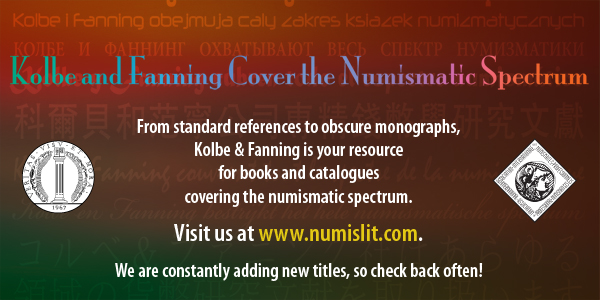
ENGRAVER GILROY ROBERTS AND THE FRANKLIN MINT
The U.S. Mint
ON SEPTEMBER 10th (2013) a special exhibit opens at Philadelphia’s Community College. A retrospective exhibit, it displays the medallic life work of Gilroy Roberts, ninth Chief Engraver of the United States Mint.
The special irony of this exhibit is that it is on display in the very building engraver Roberts did much of his work for the U.S. Mint. The building is the former Third United States Mint at 16th and Spring Garden Streets in Philadelphia.
It was replaced by the present modern plant on the Mall built under the administration of Mint Director Eva Adams. The old building, deemed of no further use for any government agency in 1969, was acquired by the Community College in 1971. Rooms formerly occupied by mint workers were refurbished into classrooms.
Gilroy Roberts was a giant among 20th century medallists, a master designer and modeler. He was recognized at the top of his craft early in his career. He started at the Mint in 1936 as staff engraver under John R. Sinnock where he received his medallic training under perfectionist Sinnock.
Medallic Art
Concurrent with his position at the Mint, Roberts was active in his home studio, creating those private commissions, all of which were made by Medallic Art Company. He became Medallic Art’s top recommended medallic artist.
When a Fortune Five Hundred company came to Medallic Art for a medal, their precepts was often “we want the finest you can produce.” The reply was often “we can commission the U.S. Chief Engraver at the Mint, should you wish. You can’t get any finer that that.”
In this capacity Roberts produced 69 medallic models of Medallic Art commissions, 1950-1965. Not quite double the 37 medals that he was required to do at the Mint during the same time. This, of course, while he was still Chief Engraver.
The Franklin Mint
After 17 years Roberts resigned his position as Chief Engraver. While this job was considered a life-time appointment, he broke a 150-year old custom by this resignation.
Enter Joseph Segel, a Philadelphia advertising specialty executive and entrepreneur. In 1964 he founded the National Commemorative Society to market medals by subscription. Its success led him to envision, and ultimately found The Franklin Mint, where he did not have to rely on outside suppliers of the proof silver coin medals he wanted to offer. He could create, produce and control these himself.
He needed a name artist at the Franklin Mint. Who better than the U.S. Mint’s Chief Engraver. But how to convince Gilroy Roberts to come aboard Segel’s proposed scheme?
Segel explained his concept to Roberts. But why would Roberts leave a cushy life-time appointment to venture into an unproven project. The answer: Segel offered Roberts the position of Chief Engraver of Franklin Mint, in addition Roberts would hold the corporate position of Chairman of the Board.
But to clinch the deal Segel offered Roberts massive amounts of Franklin Mint stock. That act made Roberts a millionaire, many times over.
Frosty Relations
News of Gilroy Roberts joining a potential competitor hit the offices of Medallic Art rather hard. It was a loss of their top sculptor talent (which could be replaced) but it was more in the loss of that personal relationship. Like the loss of a family member.
To say the relationship between Roberts and Medallic Art officials was cool, was an understatement. It was frosty. Neither side wanted to talk to the other.
For more information on the Gilroy Roberts Exhibit, see: Historic Mint collection returns to Philadelphia (www.communitycollegetimes.com/Pages/Campus-Issues/coins.aspx)
WHY PUT A SILVER PLUG IN A SILVER COIN?
Fred Michaelson writes:
I read something recently about early silver dollars with silver plugs in them to adjust the weight. I think that the one Stacks Bowers sold in January for over ten million dollars was one of them. I'm wondering if anyone can answer my question: Since the plug is the same alloy as the planchet, how can the weight be different with the plug in it?
Well, in the early days of the mint overweight planchets were typically filed down to get them to the proper value. Plugs were added to bring the value up, such as with the silver center cent. Was a silver plug also a way to bring up the value of an underweight planchet? I guess you could cut out a plug and replace it with a thicker plug. If the plugged planchet ends up being overweight, then it could be filed down. That would explain why a single coin has both a silver plug and file marks. Is that correct, readers?
THE 1952 BRITISH WEST AFRICA SIX PENCE
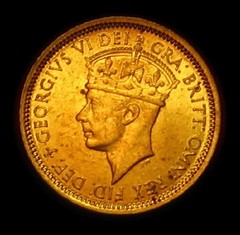

British West Africa was the name given to the British colonies in western Africa. The United Kingdom during the colonial period colonized various territories and whole regions. This lasted from the late 1780's until the 1960's.
The colonies were under a Governor-In-Chief vested in the high office of the Governor of Sierra Leone located in Freetown. The other colonies were Gambia, the British Gold Coast (now Ghana), and parts of Nigeria.
After its dissolve in the late 1950's, a single currency (the British West Africa Pound) was used throughout the region until 1962. Until then coins and currency were contracted for circulation for many years for the entire occupation. In 1952 it was decided that the entire production of the six pence (6d) for that year was to be melted. The project some 2,544,000 coins was accepted and carried out by the Riverside Metal Company in New Jersey.
This is where my story begins. In 2004, James (Jim) Henderson, Jr., a friend, introduced me to Mr. Robert (Bob) Ulrich. In 2006, Mr. Ulrich asked me to sell some coins out of his enormous collection. Within one of his four safes, I found 157 British West Africa 6d coins. I thought nothing of it at the time. They were all in very old coin tubes and had a musty smell and mold spots on them. This wasn't surprising, after all they had been kept in this particular safe for over fifty years.
With further examination I found them listed in the latest (2006) edition of Krause. Under the coin pictured in the book was a caption stating that only 167 made their way in the numismatic market. I then went back to Mr. Ulrich's home. We talked in length about them. He told me that Jim had researched them and had sent one to Krause publications. With this and the story the coins were now defined to their existence. Sadly, Jim Henderson passed away shortly after the story was documented. His recollections and input were left in his notes, which I have.
Mr. Ulrich told me that he had purchased 165 of the 167 coins that escaped the furnace. He told me that the coin dealer who had the pieces traded "Indian Head" pennies one for one to the man who brought them to him. I understand now why this trade happened. The man who worked for Riverside Metal Co. most likely did not want to be questioned of his possession with them. In any case, Mr. Ulrich bought 165 of them for $1.00 each. The dealer who had them kept one for himself and one was sent to The British Museum. That leaves eight to account for. I knew Jim had one and I am pretty sure that the other seven were sold to dealers or friends Jim knew.
In 2006, I sold most of them to Florida Numismatic Galleries in Fort Lauderdale. A few were sold to a friend and some to a couple of dealers. I bought eleven for my collection. In Krause's 2006 world coin book the uncirculated pieces were valued at $250. Stack's Bowers had one for sale in their 2011 auction. Lot 1364 listed the value between $400 and $500. Recently on the internet an example of a brilliant uncirculated specimen is priced at $1,280.
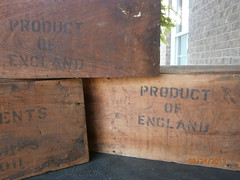
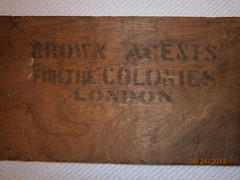
There's still one more part to the story. Mr. Ulrich passed away in 2011, and he will be sorely missed. His daughter, Clara Reitz was kind to give me the three original mahogany boxes Mr. Ulrich had. The coins were shipped in them. I would think they are the only such boxes in existence. All coins and the boxes pictured here are in my collection.
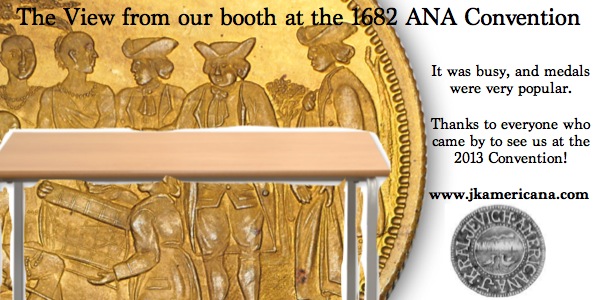
MORE ON THE FIRST NATIONAL OYSTER BANK NOTES
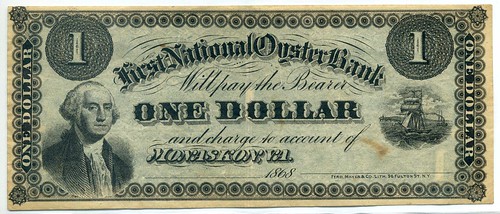
In Vol. 16, No. 25 (June 16, 2013) you showed a scan of a One Dollar "First National Oyster Bank" note from Monaskon, Va.
Last summer, we drove through Lively, Virginia (which really does not live up to its name) and visited Epping Forest Antiques. I asked about coins and tokens, but the owner, Louise deJarnette Jesse, showed me the above One Dollar note. At the time I was not collecting Virginia currency, so thanked her. Since then I have been seeking local Virginia notes with a face value of $1.00 or less. After seeing your scan, I contacted Louise Jesse to see if she still had the note. She said yes and that she had two - one unused and one signed "A. L. Carter" dated Octr, 1st, 1868" which are now in my collection. A. L. Carter was the great-great grandfather of Ms. Louise Jesse.
Ms Jessie also provided additional information about the veracity of the note as follows:
"This $1.00 bill was issued by Addison Lombard Carter during Reconstruction. Carter was an attorney, seafood packer and merchant who lived at "Midway" on the Rappahannock River in Lancaster County, Virginia. He also controlled the adjoining Monaskon Plantation which included a boat landing used on Chesapeake steam boat routes. He maintained an oyster shucking, packing and bulk shipping facility as well as other enterprises including a merchandising operation at the Monaskon landing.
The scrip came in varying full and fractional denominations [10c, 25c, 50c, $1.00 and $2.00] and is commonly titled "Oyster Money". Although the origin of the term is uncertain, it accurately reflects its use by Carter as a "value exchange currency token" given to watermen in payment for oysters that they harvested. The watermen could, in turn, redeem the notes for merchandise in Carter's Monaskon Store.
Not only were Carter's notes used during the period of the Southern Reconstruction to overcome a scarcity of legal U.S. currency, they also contain the satirical reference to the "First National Oyster Bank". No such financial institution existed but the large accumulation of oysters on the river bottom were interchangeably referred to as oyster rocks and oyster banks."
Several of the $1.00 notes have appeared in Heritage Auctions over the past decade or so, but all have been unused notes. A dealer in New England lists all of the denominations, but these too are unused. Prices range from $125. to $400. As far as know, the one from Ms. Jesse is the only signed note extant.
To read the earlier E-Sylum article, see: WAYNE'S NUMISMATIC DIARY: JUNE 16, 2013 (www.coinbooks.org/esylum_v16n25a20.html)
L. G. KAUFMAN'S BANKNOTE SIGNATURE
From Harvey Stack's article on the L.G. Kaufman “Dollars of the World" exhibit:
"The collection was formed by L.G. Kaufman, a banker of great renown at the time, and was exhibited first in New York City and Marquette, Michigan. He was president of the Chatham Phoenix National Bank and Trust Company, and collectors of U.S. currency can note his signature on National Bank Notes. The “Dollars of the World” collection was exhibited all over the United States as an educational display, and hundreds of thousands of people had the opportunity to see it before it was consigned by the Marquette Bank for auction by Stack’s."
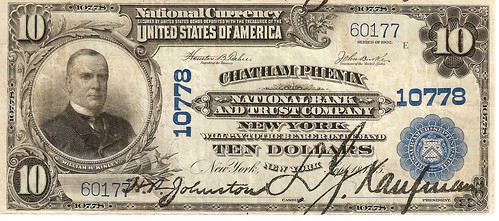
Leon Saryan writes:
I found Harvey's sketch of L. G. Kaufman interesting. I own fewer than five National Bank Notes, but one of them is a $10 large size note from the Chatham Phenix National Bank and Trust Company of New York, with Kaufman's large signature (so large that I can see traces also at the top of the note. Note the spelling of the bank name. I'll have to keep the information about the signer with my note.
To read the earlier E-Sylum article, see: L.G. KAUFMAN'S DOLLARS OF THE WORLD EXHIBIT (www.coinbooks.org/esylum_v16n34a18.html)
OCTOBER 2013 KÜNKER AUCTION SALES REVIEW
The autumn auction sale of Künker / Osnabrück once again astonishes connoisseurs. Dispersed among four sale catalogs is an offer of gold coins one hasn’t come across for a long period of time. Whether Roman aurei or gold multipla from Regensburg and the Habsburg Empire, whether rare imperial gold or Russian rarities: anyone concerned with coins is in for a surprise with these catalogs.
One attraction succeeds another – this is how the catalogs of the upcoming autumn sale of Künker’s, to be conducted between the 7th and the 11th October 2013 in Osnabrück, could be summarized. That holds true for high-denomination gold in particular, from the free imperial city of Regensburg and the Habsburg Empire: What is offered here breaks all records. It comes as no surprise then that the total estimate adds up to nearly 10 million euros. It should be stressed at this point that the other sections likewise come up with magnificent collections, for example tetradrachms from Hellenistic times and Roman gold coins for the section Antiquity.
The catalogs can be ordered at Künker, Gutenbergstrasse 23, D-49 076 Osnabrück; phone: 0541 / 96 20 20; fax: 0541 / 96 20 222; or via email: service@kuenker.de. You can find all coins four weeks prior to the sale online at https://www.kuenker.de/Unsere_Auktionen.Kuenker
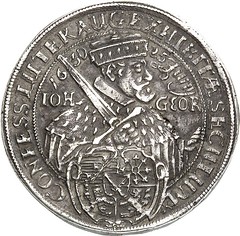
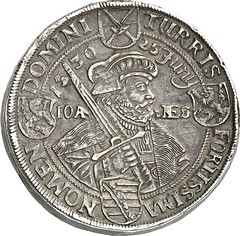
2989 Germany. Saxony. Thick quadruple reichsthaler 1630, Dresden, on the 100th anniversary of the Augsburg Confession. Schnee 857. Unique. Very fine. Estimate: 30,000 Euros

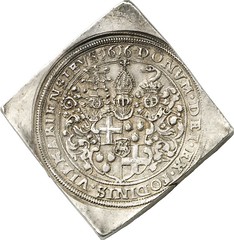
3068 Germany. Trier. Lothar of Metternich, 1599-1623. Double reichsthalerklippe 1616, Koblenz. Dav. 5881. Extremely rare. Very fine to extremely fine. Estimate: 25,000 Euros

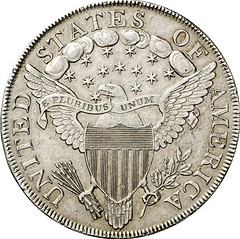
4006 United States. 1799 Dollar
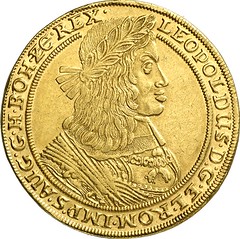

5663 Holy Roman Empire. Leopold I, 1657-1705. 10 ducats 1663 GH, Breslau. Fb. 258a. Unedited unique specimen. About extremely fine. Estimate: 125,000 Euros

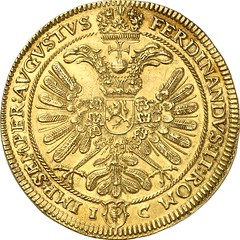
6141 Holy Roman Empire. County of Schlick. Henry IV, 1612-1650. 10 ducats 1634, mining coinage. Fb. 114. Extremely rare. Extremely fine. Estimate: 125,000 Euros
To view the catalogs online, see: www.kuenker.de/Unsere_Auktionen.Kuenker
MONEY & MEDALS AUGUST 2013 ISSUE PUBLISHED
Money & Medals is the numismatic publication associated with the Money and Medals Network based at the British Museum and in association with the RNS, BNS and a number of key partner museums. The Network aims to act as an information exchange for curators within the UK whose collections include coins, medals and other objects relating to monetary and economic history and numismatics.
Rounding out the issue were short reports from attendees on numismatics at their home museums. Here's a report from Vicki Slade of the Leamington Spa Art Gallery & Museum, which highlights an interesting medal from their collection. -Editor
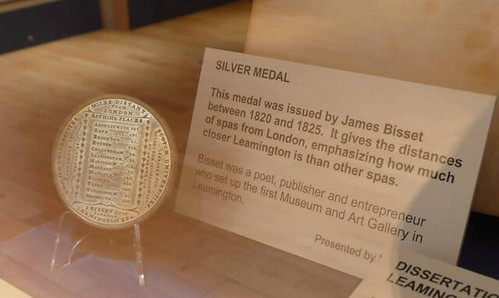
Numismatics at Leamington Spa Art Gallery & Museum
Vicki Slade, Senior Curatorial Officer,
Leamington Spa Art Gallery & Museum
Leamington Spa Art Gallery & Museum has a numismatics collections of just over 1,200 objects. The overwhelming majority are coins, although there are a small number of tokens and some examples of paper money from local banks. There is at least one item from each continent, although they originate predominantly from Britain and Europe. With a few exceptions, the coins were donated by just three collectors.
Notable amongst the collection is a token recording the distance of spa towns from London, which was produced to promote Leamington Spa. This is on permanent display, as is a local trade token and three coins from Ceylon. We also have an impressive cowrie shell disk, which is said to be the ‘price of a wife’.
We don’t have a specialist curator and items from the numismatic collection are usually only displayed to add context to social history exhibitions, rather than as objects in their own right. We decided to join the Money and Medals Network to get advice and support that would enable us to make better use of the collection. The meeting with Henry proved very productive in this regard: we came up with several ideas for displays and discussed ways to improve access. I’m now planning a display that traces the history of money from cowrie shells to plastic, and am managing a volunteer-run project to improve storage.
For more information on the Money & Medals Network, see: www.moneyandmedals.org.uk/
THE BOOK BAZARRE
TURKISH MUSEUM EXHIBITS ANCIENT COINS
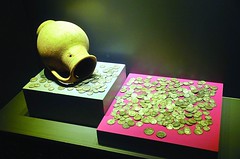 Providing a treasure trove of artifacts for numismatists, an archaeology museum in Aydýn is showing off a large collection of silver coins dating back to between 270 and 40 B.C.
Providing a treasure trove of artifacts for numismatists, an archaeology museum in Aydýn is showing off a large collection of silver coins dating back to between 270 and 40 B.C.
The coins include the visages of empresses and emperors, revealing history from more than 2,000 years ago.
Aydýn Culture and Tourism official Nuri Aktakka said the collections dated from the Roman era and shed light on the culture of the day.
“This coin collection has been excavated from works at Nazilli Kýzýldere. They belong to an emperors’ collection from 270 to 40 B.C. We know that these emperors ruled the city and that they created coins for themselves,” he said.
The coins also signify an important part of the culture of coin collection, as well as the use of tin in the era, according to Aktakka.
“The historical collection displays the coins by emperors such as Hadrian, Commodus, Gordian and Marcus Aurelius, and also the empresses Crispina and Faustina I and II,” he said, adding that Emperor Hadrian was born Publius Aelius Hadrianus to an ethnically Italian family.
The museum also gives information on how the coins were crafted and how people worked on the coins to engrave pictures on them.
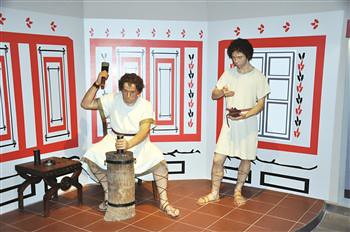
To read the complete article, see: Coins displayed at museum reveals Aydýn’s ancient past of Roman era (www.hurriyetdailynews.com/coins-displayed-at-museum-reveals-aydins-ancient-past-of-roman-era.aspx?pageID=238&nID=52599&NewsCatID=375)
THE NUMISMATICS MUSEUM OF UDUPI, INDIA
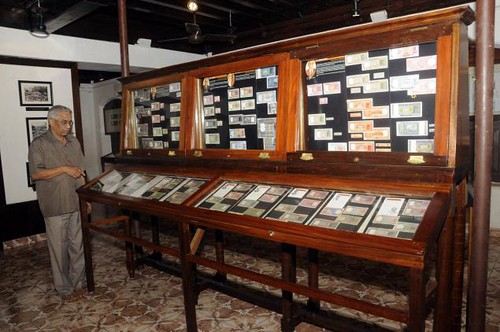
If you like seeing ancient coins and understand history through coins, the Numismatics and Notaphily Museum, a part of the Corporation Bank Heritage Museum in the heart of Udupi, is the place for you.
Nearly 1,800 coins from 400 B.C. to the present times are on display at Corporation Bank. Coins in materials such as gold, silver, copper, lead, nickel and steel are on display. There is explanation in English besides all the coins. “We will soon provide explanation of coins in Kannada on each exhibit stand,” said M.K. Krishnayya, curator of the museum.
The oldest coins at the museum date back to Gandhara Janapada (400 B.C.–350 B.C.). Coins from a variety of eras and kingdoms from Surasena Janapada (350 BC to 2 AD) to Tippu Sultan can be foundA separate section displays coins issued by East India Company, French, Dutch, Portuguese and British Indian Government as well as the post Independence period, including the “Anna” series of coins, Naya Paisa and Paisa systems can be found here. There is a commemorative coins section, where coins of Rs. 1,000, Rs. 100, Rs. 50, and Rs. 20 denomination are on display.
There is a section which deals with currency notes issued since the Independence alongside a brief history of the Governors of Reserve Bank of India.
Mr. Krishnayya said: “I am trying to construct a story of banking development in the country through stamps and postal stationary such as stamps, cards, inland letters, which will be displayed in the museum.”
To read the complete article, see: For a change, visit Udupi’s numismatics museum (www.thehindu.com/news/cities/Mangalore/for-a-change-visit-udupis-numismatics-museum/article5048304.ece)
NUMISMATIC VOCABULARY WORDS: CRORE AND LAKH
I was interested to read about India’s attempt to clean up its banknotes by prohibiting the addition of graffiti and other messages to its paper money. Curiously, the article suggested that bank employees are the biggest offenders, although it did not make clear why they are so prone to writing on banknotes. It also mentioned that an unknown Kashmiri separatist group has been stamping separatist slogans on Indian currency and claims to have “stamped currency worth Rs 30 crores in the last four months.”
I was pretty confident that “Rs” stood for Rupees, but I had to re-read the sentence a few times to make sure I was seeing the word “crores”, and then I had to go look that up. For those E-Sylum readers as uneducated as I am, here is what Wikipedia says:
“A crore (/ˈkrɔər/; abbreviated cr) is a unit in the South Asian numbering system equal to ten million (10,000,000; Scientific notation: 107), which is written as 1,00,00,000, equal to a hundred lakh (lakh is written as 1,00,000). It is widely used in: India, Bangladesh, Pakistan, Nepal and Sri Lanka. In Pakistan, the South Asian numbering system is used in Hindi, but not in English.”
Got that? I’m not sure I do. Not only do I need to remember a new word (two new words if I want to be able to convert a “crore” into “lakh”), but I also need to learn a new way to write the number 10,000,000.
In any case, you correctly noted that “such a policy in the U.S would apply to a wide swath of overstamped notes such as ‘Where's George?’ notes and various political slogans, like ‘Obama Rocks’ ". I am sure that there are a few crores of “Where’s George” notes floating around the US and beyond, and although the “Obama Rocks” notes are not quite as ubiquitous, there must be a lakh or two of those in circulation as well.
To read the earlier E-Sylum article, see: INDIA'S CLEAN BANKNOTE POLICY (www.coinbooks.org/esylum_v16n34a28.html)

MORE ON 3D PRINTING AND NUMISMATICS
"And a few weeks ago we completed the acquisition of 81% of Phoenix System, a leading global provider of Direct Metal Selective Laser Sintering systems that's based in rearm fronts.
Phoenix designs manufactures and sells proprietary Direct Metal 3D Printers that can print chemically pure fully dense metal and ceramic parts from very fine powders with the granularity of 6 microns to 9 microns. Materials include stainless steel, tool steel, super alloys, nonferrous alloys, precious metals and alumina for a variety of advance aerospace automotive and patient specific medical device applications."
To read the complete article, see: 3D Systems Can Hardly Meet Demand (seekingalpha.com/article/1645352-3d-systems-can-hardly-meet-demand?source=email_rt_article_readmore)
To read earlier E-Sylum articles, see:
NEW TECHNOLOGY CREATES NUMISMATIC ITEMS IN 3D
(www.coinbooks.org/esylum_v16n05a19.html)
A 3D PRINTED BOOK OF TEXTURES AND RELIEFS
(www.coinbooks.org/esylum_v16n29a22.html)
NOTES FROM E-SYLUM READERS: JULY 21, 2013 : Scary Hobby Ramifications of 3D Printing
(www.coinbooks.org/esylum_v16n30a12.html)
CACHE OF DECADES-OLD UNTOUCHED CLASSIC AUTOS TO BE SOLD
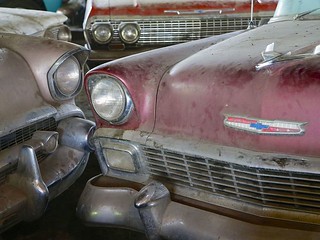 Seventeen years have passed since Ray Lambrecht closed his Chevrolet dealership, a small-town operation in northeast Nebraska with a big and valuable secret.
Seventeen years have passed since Ray Lambrecht closed his Chevrolet dealership, a small-town operation in northeast Nebraska with a big and valuable secret.
For decades, the owner of the Lambrecht Chevrolet in Pierce held on to new cars and trucks that didn't sell right away. He stashed them in warehouses, at his farm and in other spots around the town he worked in for 50 years.
Now, his automotive nest egg — about 500 vintage cars and trucks — will go on the auction block. Next month, visitors from at least a dozen countries and throughout the U.S. will converge on the 1,800-resident town, or bid online.
The two-day auction will feature mostly unsold Chevrolets that have sat untouched for decades. They'll go on the block in as-is condition. About 50 have fewer than 20 miles on the odometer, and some are so rare that no one has established a price. The most valuable, including a rare Chevy Cameo pickup, could fetch six-figure bids from collectors who view them as works of art to display or as restoration projects.
"To find this many new, old vehicles is unheard of," said Yvette VanDerBrink, the auctioneer coordinating the event. "It's like a white buffalo."
Preparations for the auction began in June, and VanDerBrink has taken calls from as far as Iceland, Singapore and Brazil. The two least-driven cars, a 1959 Bel Air and a 1960 Corvair Monza, each have one mile on their odometer. The oldest vehicle with fewer than 20 miles dates to 1958; the newest is a 1980 Monza with nine miles.
Ray Lambrecht opened the downtown dealership with his uncle in 1946, on the corner of Main Street and Nebraska Highway 13. Live elephants meandered out front that day, with Chevrolet banners across their backs.
Lambrecht rarely sold cars or pickups that were more than a year old, and he used holdover models as a kind of rainy-day fund. Unlike most dealers who lowered prices to move out-of-date inventory, he assumed the older cars would appreciate over time.
"I believe that Dad's sales approach reflected his personal style," said his daughter, Jeannie Stillwell. "He is a very honest, straightforward man who was focused on giving his customers the best price right from the start. Negotiating over price was a waste of time, and so that element of the sale was eliminated."
The most valuable vehicles were stored for decades at a nearby warehouse, until a heavy snow collapsed the roof. Some were damaged, but many were saved and moved elsewhere. And the models at the dealership are among the best preserved, even as the building gave way to bats and holes in the roof.
To read the complete article, see: Vintage Chevy auction to deal in low-mileage gems (www.usatoday.com/story/money/cars/2013/08/21/chevy-chevrolet-auction-nebraska-corvair-silverado-cameo/2682061/)
ON MADE-UP MEDICAL TERMS AND LIMERICKS
Bob Neale writes:
I was way more than just impressed with your creation of new words at Her Majesty's expense. In fact, if you keep this up, you'll make an addict of me (yes, it was hard to refrain from Homrenizing that). Please keep composing novel words until they lay you in that ultimate box, when you can begin undoing your ripening of the language by decomposing.
Paul Bosco writes:
Your words are probably not as serious an offence as is the inclusion --incursion?!-- of LIMERICKS --that lowest, lousiest and Leariest of all poesies-- in(to) our highbrow weekly.
On the Prudishness of Ron Guth
I thought Mr. Guth in denial
When the "prig" charge he sought to revile.
But he pulled off the trick
By uttering "prick".
No prude uses words so penial.
To read the earlier E-Sylum article, see: THE E-SYLUM ROYAL ... POETRY CORNER (www.coinbooks.org/esylum_v16n34a30.html)
FEATURED WEB PAGE: COLLECTING PAPAL COINAGE
This week's Featured Web Page is an article on Collecting Papal Coinage by David Sorenson on the Pegasi Numismatic web site.
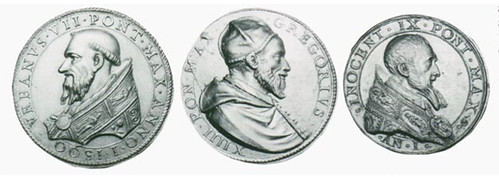
www.pegasionline.com/article.asp?id=7023
